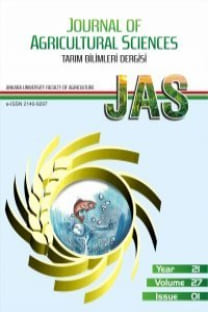A Study on Milk Compositions of Hair Goat and Saanen x Hair Goat Crossbreed (F1) under Semi-Intensive Conditions
A Study on Milk Compositions of Hair Goat and Saanen x Hair Goat Crossbreed (F1) under Semi-Intensive Conditions
___
- Abdelsalam M, Eissa M, Maharm G & Heider A (2000). Improving the productivity of the Barki goat by crossbreeding with Damascus or Zaraibi breeds. Alexandria Journal of Agricultural Research 45(3): 33-42
- Addass P, Tizhe M, Midau A, Alheri P & Yahya M (2013). Effect of genotype, stage of lactation, season and parity on milk composition of goat. Annals of Biological Research 4(8): 248-252
- Cak B, Yilmaz O & Ocak E (2017). Physical-Chemical Composition of Milk and Fiber Quality in Hair Goats and the Phenotypic Correlations between Milk Composition and Fiber Traits. Pakistan Veterinary Journal 37(1): 35-38
- Ciappesoni G, Pribyl J, Milerski M & Mares V (2004). Factors affecting goat milk yield and its composition. Czech Journal of Animal ScienceUZPI (Czech Republic) 49(11): 465-473
- Çak B & Demirel A F (2018). Physical and Chemical Properties of Milk with Excellent Nutritional Source for Humans. In: H. Arapgirlioglu, A. Atik, S. Hızıroglu, R. Elliott, D. Atik, & editörler (Eds.), The Most Recent Studies in Science and Art, Gece Kitaplığı, Ankara, pp. 523- 536
- Güler Z, Keskin M, Masatçioğlu T, Gül S & Bicer O (2007). Effects of Breed and Lactation Period on Some Characteristics and Free Fatty Acid Composition of Raw Milk from Damascus Goats and German Fawn x Hair Goat B_1 Crossbreds. Turkish Journal of Veterinary and Animal Sciences 31(5): 347-354
- Haenlein G (2004). Goat milk in human nutrition. Small Ruminant Research 51(2): 155-163 10.1016/j.smallrumres.2003.08.010
- Idowu S T & Adewumi O O (2017). Genetic and non-genetic factors affecting yield and milk composition in goats. Advances in Dairy Research 5(2): 175 10.4172/2329-888X.1000175
- Kanwal R, Ahmed T & Mirza B (2004). Comparative analysis of quality of milk collected from buffalo, cow, goat and sheep of Rawalpindi/Islamabad region in Pakistan. Asian Journal of Plant Sciences 3(3): 300-305
- Keskin M, Avşar Y K, Biçer O & Güler M B (2004). A comparative study on the milk yield and milk composition of two different goat genotypes under the climate of the Eastern Mediterranean. Turkish Journal of Veterinary and Animal Sciences 28(3): 531-536
- Kondyli E, Svarnas C, Samelis J & Katsiari M (2012). Chemical composition and microbiological quality of ewe and goat milk of native Greek breeds. Small Ruminant Research 103(2-3): 194-199 10.1016/j.smallrumres.2011.09.043
- Kosikowski F. (1982). Cheese and Fermented Milk Foods (2nd ed.). New York: F. V. Kosikowski & Associates.
- Kurt A, Cakmakci S & Caglar A. (2003). Guide of inspection and analysis methods in milk and milk products. Erzurum: Agricultural Faculty Press.
- Merin U, Rosenthal I & Maltz E (1988). The composition of goat milk as affected by nutritional parameters. Milchwissenschaft 43(6): 363- 365
- Mestawet T, Girma A, Ådnøy T, Devold T, Narvhus J & Vegarud G (2012). Milk production, composition and variation at different lactation stages of four goat breeds in Ethiopia. Small Ruminant Research 105(1-3): 176-181 10.1016/j.smallrumres.2011.11.014
- Min B, Hart S, Sahlu T & Satter L (2005). The effect of diets on milk production and composition, and on lactation curves in pastured dairy goats. Journal of Dairy Science 88(7): 2604-2615 10.3168/jds.S0022-0302(05)72937-4
- Mioč B, Prpić Z, Vnučec I, Barać Z, Sušić V, Samaržija D & Pavić V (2008). Factors affecting goat milk yield and composition. Mljekarstvo 58(4): 305-313
- Monaci L, Tregoat V, van Hengel A J & Anklam E (2006). Milk allergens, their characteristics and their detection in food: a review. European Food Research and Technology 223(2): 149-179 10.1007/s00217-005-0178-8
- Prasad H, Tewari H & Sengar O (2005). Milk yield and composition of the beetal breed and their crosses with Jamunapari, Barbari and Black Bengal breeds of goat. Small Ruminant Research 58(2): 195-199 10.1016/j.smallrumres.2004.10.002
- Rezaei R, Wu Z, Hou Y, Bazer F W & Wu G (2016). Amino acids and mammary gland development: nutritional implications for milk production and neonatal growth. Journal of animal science and biotechnology 7(1): 20 10.1186/s40104-016-0078-8
- SPSS. (2006). IBM SPSS statistics version 13.0 for Windows Turkstat (2017). Turkstat Livestock Statistic. Retrieved in May, 20, 2018 from https://biruni.tuik.gov.tr/hayvancilikapp/hayvancilik.zul Turkstat (2018). Turkstat Livestock Statistic. Retrieved in July, 19, 2019 from http://www.tuik.gov.tr/PreTablo.do?alt_id=1002
- Yayın Aralığı: 4
- Yayıncı: Ankara Üniversitesi Basımevi
Masoud SADEGHİ, Abdolamir MOEZZİ, Ali GHOLAMİ, Teimour BABAEİNEJAD, Ebrahim PANAHPOUR
Meta-Learning-Based Prediction of Different Corn Cultivars from Color Feature Extraction
Mahmut ÇETİN, Recep YURTAL, Muhammet Said GÖLPINARb, Abdullahi Ali SAID
Mustafa KAYMAKÇI, Funda ERDOĞAN ATAÇ
Musa Sarıca, Umut Sami YAMAK, Mehmet Akif BOZ, Ahmet UÇAR
Funda ERDOĞAN ATAÇ, Mustafa KAYMAKÇI
Aydın ÜNAY, İbrahim SABANCI, Volkan Mehmet ÇINAR
Selin Nur ÖZDEMİR, Sibel YORULMAZ
Abdullahi Ali SAİD, Recep YURTAL, Mahmut CETİN, Muhammet Said GÖLPINAR
